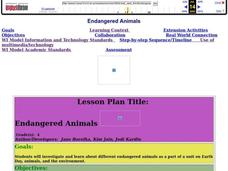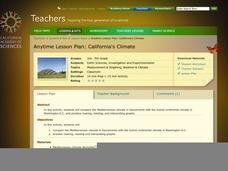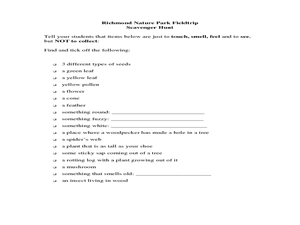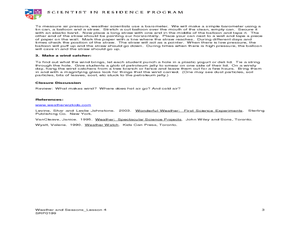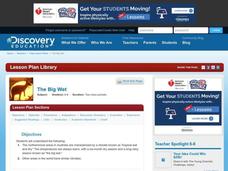Curated OER
Volcano
Middle schoolers research major volcanic eruptions. In this Earth science lesson, students take on the role of vulcanologist writing reports to the President of the United States on how to respond to a volcanic disaster. This lesson...
Curated OER
Woman Power!!! Mathematics Camp
Students explore mathematics by researching stereotypes. In this gender bias instructional activity, students participate in discussions where they identify traditional careers according to their own gender. Female students attend summer...
Curated OER
You Are Here
Students determine the relative size and distance of the planets in the solar system. They use ratios in their mathematical calculations to make models of the planets after discussing the relative sizes of the planets. They keep a...
Curated OER
Plant Pipes
Students work together to discover the path water follows in plants. They create multicolored flowers. They label each part of the plant and note their function.
Curated OER
Letting Off Steam
Students examine the concept of transpiration. They work together to complete an experiment in which they see water loss in plants. They record their observations and discuss their conclusions.
Curated OER
Endangered Animals
Fourth graders research different endangered animals in media center as part of unit on Earth Day, animals, and environment, create project based around multiple intelligence related to an endangered animal, and produce Powerpoint...
Curated OER
Oklahoma's Berry Best
Ask your learners to complete activities related to Oklahoma's agriculture, berries in particular. The lesson is cross-curricular and has class members investigate an article about berries, write an acrostic poem, and discuss new...
Curated OER
Learning Lesson: The Shadow Knows II
Students discover and practice how to calculate the circumference of the Earth. They measure the length of their shadows and use the distance they are away from the equator to complete the calculations. They discuss winter or summer...
Curated OER
Fastest Glacier
Students compare and contrast continental ice sheets and a glacier. They discuss how glaciers form. Students research the average winter and summer temperatures for their area. They predict what might happen to the Greenland...
Teach Engineering
Solar Angles and Tracking Systems
The sun will continue to rise in the east and set in the west, no matter what. The first lesson in a series of eight introduces the class to solar angles. It makes connections between a person's latitude and the angle of position of the...
California Academy of Science
California's Climate
The United States is a large country with many different climates. Graph and analyze temperature and rainfall data for Sacramento and Washington DC as you teach your class about the characteristics of Mediterranean climates. Discuss the...
Curated OER
Sun Friendly Homes
Students design and build a model solar energy home. In this technology lesson, students test the efficiency of their model houses by measuring temperature at regular intervals. They analyze data and share results with the class.
Curated OER
Make a Natural Weaving
Pupils use natural materials and yarn to create weavings. In this natural weaving lesson, students find large branches to act as the loom, use other natural objects to act as designs within the weave, and use fine motor skills to wrap...
Curated OER
Ozone Pollution: Smog Alert
Students examine factors the create smog. In this pollution lesson plan students complete an activity about ozone.
Curated OER
Hominid Diet
Students listen to an interview with Lucinda Backwell regarding fossil evidence that early hominids included termites in their diets. They participate in a discussion to investigate the significance of these findings.
Curated OER
Climate and Weather
Students become familiar with weather terminology and different representations of data as they explore various on-line weather sites. They practice using and interpreting data determining the effects of the time of day, time of year and...
Curated OER
Magical Metamorphosis
Sixth graders compare and contrast incomplete and complete metamorphosis using a Venn Diagram. They predict, observe, measure, and record data on the life cycle of mealworms. Students write and illustrate the life cycle of the mealworm....
Curated OER
Richmond Nature Park Field Trip
Learners identify different plants and their uses by attending a field trip. In this Canadian plant lesson, students explore the great outdoors of Vancouver, B.C. and discuss the uses of plants by the Native Americans that once resided...
Curated OER
Wind and Air Pressure
Pupils make an anemometer, barometer, and wind catcher to see how wind and air pressure are related. In this wind lesson plan, students use these tools to measure the wind speed.
Curated OER
The Big Wet
Students complete a research project. In this climate lesson, students learn about the climate "tropical wet and dry" found in Australia. Students work in groups to research aspects of this climate and then create a class presentation.
Curated OER
Reflections on Earth: Exploring Planet Earth from Space
Students examine satellite images of Earth and contrast images at different scales. For this exploring Earth from space lesson plan, students use satellite images to contrast images at different scales, calculate distances from the scale...
Curated OER
Planting Seeds Around the World
First graders discuss the book The Lorax and research what living things need. In this environmental lesson, 1st graders investigate how humans affect the growth of plants. Students conduct an experiment with sunflowers.
Curated OER
On the Attack
Young scholars explore how government restrictions and over fishing impact the ecosystems of sharks and contribute to or curb their danger to humans. They synthesize their understanding of the issues by creating board games in groups.
Curated OER
Heading South
Students look at the migration of different birds. In this migration activity, students discuss why an animal migrates and problems that can occur during migration. They look at several downloadable maps that show the specific routes of...







